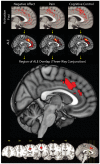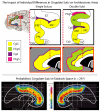The integration of negative affect, pain and cognitive control in the cingulate cortex
- PMID: 21331082
- PMCID: PMC3044650
- DOI: 10.1038/nrn2994
The integration of negative affect, pain and cognitive control in the cingulate cortex
Abstract
It has been argued that emotion, pain and cognitive control are functionally segregated in distinct subdivisions of the cingulate cortex. However, recent observations encourage a fundamentally different view. Imaging studies demonstrate that negative affect, pain and cognitive control activate an overlapping region of the dorsal cingulate--the anterior midcingulate cortex (aMCC). Anatomical studies reveal that the aMCC constitutes a hub where information about reinforcers can be linked to motor centres responsible for expressing affect and executing goal-directed behaviour. Computational modelling and other kinds of evidence suggest that this intimacy reflects control processes that are common to all three domains. These observations compel a reconsideration of the dorsal cingulate's contribution to negative affect and pain.
Figures





References
-
- Brodmann K. The principles of comparative localisation in the cerebral cortex based on cytoarchitectonics. Springer; New York: 1909/2005. Brodmann’s: Localisation in the cerebral cortex.
-
- Papez JW. A proposed mechanism of emotion. Arch Neurol Psychiatry. 1937;38:725–733.
-
- Tracey I, Mantyh PW. The cerebral signature for pain perception and its modulation. Neuron. 2007;55:377–391. - PubMed
-
- Vogt BA, Sikes RW. Cingulate nociceptive circuitry and roles in pain processing: The cingulate premotor pain model. In: Vogt BA, editor. Cingulate neurobiology and disease. Oxford University Press; NY: 2009. pp. 311–338.
Publication types
MeSH terms
Grants and funding
LinkOut - more resources
Full Text Sources
Other Literature Sources
Medical

